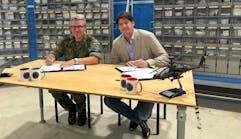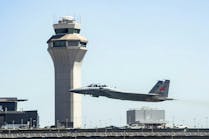Over the last few years, Lockheed Martin has been busy manufacturing the world’s latest fighter attack jet. The F-35 Joint Strike Fighter (JSF) with its three different variants is an example of the best of the best.
The F-35 JSF is a significantly different aircraft compared to legacy fighters, such as the F-18 and F-16, it’s designed to replace:
- The F-35 needs 270v DC ground power, not 400 Hz.
- It also needs high-pressure cold dry air supplied to it for ground operations.
Full production of the aircraft is not expected until 2019, but hangars have been in the works for more than four years. The new hangars that support this fantastic aircraft can’t be just ordinary hangars. They need to have the latest in technology and safety built into them. What used to work for hangar design doesn’t necessarily apply anymore.
With a handful of these hangars 100 percent up and running and many more being built both in the United States and in some NATO countries, how is the learning curve going?
Our exclusive military distributor B GSE Group, based in Huntersville, NC, and its employees have been involved in almost every F-35 hangar design to date in some form or another.
Scott Dils, vice president of sales and marketing, B GSE Group, informs me that we are currently through most of the learning curve. Which is not to say that there haven’t been a few very long years since there’s been much to learn.
POWER SUPPLY
The F-35 uses 270v DC power. This power supply is more advanced and different in almost every way than 400 Hz power we are used to.
Like 28v DC, it is more difficult to have long cable runs from the power supply to the aircraft. In other words, central 270v DC systems or putting this power supply far away from the aircraft is not possible.
The F-35 is also a very smart aircraft. If the quality of the 270v DC provided from the converter, or the 28v DC E&F safety power circuit is not the perfect voltage, amperage or harmonics at the aircraft plug, the aircraft will not accept the power and will not turn on when the ground crew hits the external power switch. Nobody likes it when that happens.
Due to required, shortened 270v DC cable lengths, the power converter will most often be located in the hangar.
However, if the hangar will also service legacy aircraft, space may not be available to fit the converters along the hangar wall. Solutions have ranged from raised platforms, hangar ceiling mounts and high wall-mounting solutions. Many specialized designers have had to change the way they think if they have done 400 Hz hangars in the past and now are designing for 270v DC power.
Running these cables across the ground is also not very feasible. These are very expensive cables that contain a lot of smaller, easily damaged conductors.
It’s been a real design challenge and the solution most widely accepted has been through subterranean service PITs.
SERVICE PITS
Service PITs are the most popular way to provide multiple sources of required service points right at the aircraft without running any cables or hoses across the hangar floor.
It also solves the problem of taking up valuable hangar floor space and not causing potentially dangerous situations with hard-mounted podium service tables for equipment in the middle of the hangar floor.
At Luke AFB, located outside Glendale, AZ, Dils says that B GSE Group has designed, with the help of USS PIT Co., an all-in-one everything you need PIT for the F-35 – 270v DC power, 28v DC power, 120-volt receptacles, multiple 480-volt receptacles, dual shop air for pneumatic air tools, high pressure PCA for the F-35, remotes and automation like no other hangar seen to date.
Without taking up valuable hangar floor space, cable and hose to provide the F-35 with its required power and air can be brought directly into position and then stowed away under the hangar floor with the push of a button.
This product has a hydraulic pop up lid that lifts itself 3 feet in the air to provide all of this convenience. This type of pit is a graduate from the old pulley and weight design that had personnel pulling and pushing to assist it to rise up and down. With all of this equipment packed in this well-organized PIT system, there is no need to run one cable across the hangar other than from the PIT to the aircraft.
PCA
With the F-35’s multiple, complex onboard electronic systems, the PCA requirements are very difficult for the F-35. Not too hot … not too cold … it has to be very dry air and at a higher pressure than normal commercial PCA requirements.
This balancing act would be hard enough with aircraft mobile units, but these modern hangars have to have underground trunk-line systems with the actual units outside the hangar.
B GSE Group and JBT were challenged a few years ago to come up with the first fully compliant F-35 unit called a HPC-F (High Pressure Air-Conditioner-Fixed). This is an amazing unit.
A trunk line system means that several HPC-F units are ducted into a common hard underground pipe and then divided off to each PIT location. There can be more PITs than air units so the logic to make sure every PIT has the right requirements of air with the common trunk line and multiple distances to each PIT can only be done with refined logic.
With a push of a button on the EZ access PIT remote, the operation of the PCA unit, the motorized butterfly valves and the preprogrammed fast cool down sequence is all started up. This is truly one of the most automated aircraft service PCA systems in the world.
SAFE POWER
One power supply proven to be deadly is 480-volt power. Several types of F-35 mobile GSE need 480-volt power to be available near the F-35 in service PITS. A built-in safety system is required to ensure the airmen plugging this equipment into them do not accidently get hurt.
B GSE Group has helped develop a “Safety Service System” that is incorporated into these PITs. This system makes it impossible to plug into an active high voltage receptacle.
All of the equipment in the service PITs in these modern hangars are required to be explosion-proof. After two years of research and development, B GSE Group now offers the fully compliant NEMA 7 explosion-proof EZ Access PIT with all of the service points required to be at the aircraft.
Careful layout and products specially made for the USS EZ Access Pop Up style PIT accomplish this. Also, whenever the PIT goes down, all power supplies are automatically shut off just in case one was left on.
MULTIUSE
The F-35 hangars also need to be multi-squadron ready. For instance, a Harrier squadron could occupy the F-35 hangar at some point. This aircraft, like most of the other legacy fighter aircraft, is based on 400 Hz power.
Dils has worked with JBT to develop a 270v DC/400 Hz combination unit. The combo units are ready to supply either generation fighter jet making the hangar ready for all squadrons. The PITs can handle the additional 400 Hz aircraft cable without any modification.
The F-35 JSF is a remarkable aircraft. The hangars being designed and built will be the most modern hangars erected to date.
The use of a new type of power supply, complex PCA requirements and the need to organize many service points underground to a single point of supply has made the F-35 hangars a modern hangar for a modern jet.
About the author: Bryan Bullerdick has worked in the industry since 1993 and is a B-737 retired pilot and instructor. Bullerdick is the sales manager for the JBT Aerotech’s new JASE division with core products in aircraft power and preconditioned air systems.



